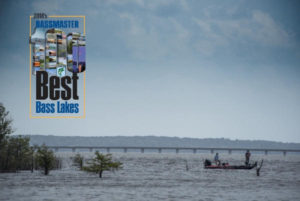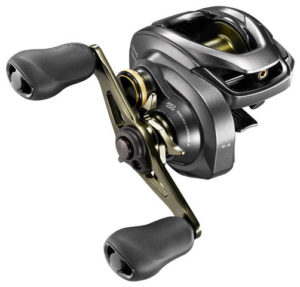Texas’ Sam Rayburn Named Nation’s Top Bass Lake
from The Fishing Wire

Best bass lake in the US?
Bassmaster Magazine has released the 2018 rankings for the 100 Best Bass Lakes in America, and Sam Rayburn Reservoir, Texas, has been named the No. 1 fishery in the country. Photo by B.A.S.S.
BIRMINGHAM, Ala. — After three years of hovering in the Top 5 of Bassmaster Magazine’s 100 Best Bass Lakes rankings, Texas’ Sam Rayburn Reservoir finally takes the crown for being the best bass lake in the nation for 2018.
The storied Lone Star State fishery has never ranked below 26th in the seven years the rankings have been published. However, the 114,500-acre lake started showing out in 2015, when it climbed to fifth. In 2016 it jumped to fourth. And last year, Rayburn was the bridesmaid, sitting in second place. But, Rayburn is a bridesmaid no more, and for the first time captures the title.
“Although there were some pretty spectacular numbers being produced from other lakes this year, Rayburn was a clear No. 1,” said James Hall, editor of Bassmaster Magazine. “While some lakes were boasting of a single 30-pound, five-bass limit being caught, Rayburn was spitting them out in rapid succession. And to top it off, a 40.28-pound limit was recorded in June.”
Countless limits of solid fish aren’t the only thing special about this lake.
“When it comes to double-digit bass, Rayburn also seems to top the list this year,” Hall continued. “Three 10-pounders were weighed in during a one-day February derby. Plus, a 12.05 and a 13.06 were landed here in March. The lake is simply on fire right now.”
The process to create the rankings takes about three months to complete. Data is received from state fisheries agencies across the U.S. This is coupled with catch data collected from dozens of tournament organizations across the country from the past 12 months. After the numbers are crunched, a blue-ribbon panel from the bass fishing industry debates the strength of the lakes, then settles on the final rankings.
The rankings identify the Top 10 lakes in the nation regardless of location, as well as the Top 25 lakes in four geographical divisions. “By dividing the Top 100 into four regions, anglers have perspective on fisheries nearby,” Hall explained.
Tennessee’s Chickamauga Lake, which takes the No. 2 slot this year, made a strong argument for No. 1, as it also produced 40-plus-pound limits this spring. Yes, that was plural — two five-fish limits exceeding 42 pounds were landed this year. Although this 36,240-acre fishery hasn’t produced quite as many big fish as Rayburn, there were two bass over 10 pounds recorded here since February, the biggest weighing 11.21 pounds.
California’s Clear Lake landed in the No. 3 position on the strength of its production of big largemouth. Lake St. Clair, a former No. 1 in 2013, climbed from ninth last year to the fourth spot in 2018, while Minnesota’s Mille Lacs Lake (last years’ No. 1 fishery) fell to No. 5. The remainder of the nation’s Top 10 are: sixth, Santee Cooper lakes (Marion/Moultrie), South Carolina; seventh, Diamond Valley Lake, California.; eighth, Thousand Islands (St. Lawrence River), New York; ninth, Lake Guntersville, Alabama; 10th, Falcon Lake, Texas.
Other highlights include the comeback of Lake Guntersville, which has finally turned the corner on several subpar years of production for the stalwart fishery. Newcomers to the rankings include Texas’ Belton Lake, Arkansas’ Lake Chicot, Maryland’s Potomac River, Mississippi’s Lake Ferguson and Oregon’s Tahkenitch Lake.
When it comes to bragging rights for the state with the most lakes to make the Top 100 list, Texas wins with 12. California boasts eight fisheries within the rankings, while Florida has the third most with seven.
Bassmaster’s 100 Best Bass lakes will be published in a 12-page section of the July/August issue ofBassmaster Magazine. The complete rankings can also be found in Bassmaster.com photo galleries.
2018 List Of Bassmaster Magazine’s 100 Best Bass Lakes
Rank Fishery State
Top 10
1 Sam Rayburn Reservoir Texas
2 Chickamauga Lake Tennessee
3 Clear Lake California
4 Lake St. Clair Michigan
5 Mille Lacs Lake Minnesota
6 Santee Cooper lakes (Marion/Moultrie) South Carolina
7 Diamond Valley Lake California
8 Thousand Islands (St. Lawrence River) New York
9 Lake Guntersville Alabama
10 Falcon Lake Texas
Central
1 Sam Rayburn Reservoir Texas
2 Mille Lacs Lake Minnesota
3 Falcon Lake Texas
4 Toledo Bend Reservoir Texas/Louisiana
5 Sturgeon Bay Wisconsin
6 Lake Conroe Texas
7 Lake Lyndon B. Johnson Texas
8 Lake O’ the Pines Texas
9 Millwood Lake Arkansas
10 La Cygne Lake Kansas
11 Lake Ray Roberts Texas
12 Lake Palestine Texas
13 Grand Lake O’ the Cherokees Oklahoma
14 Lake of the Ozarks Missouri
15 Lake Dardanelle Arkansas
16 Bull Shoals Lake Arkansas
17 Caddo Lake Texas/Louisiana
18 Newton Lake Illinois
19 Lake Ouachita Arkansas
20 Lake Oahe South Dakota
21 Belton Lake Texas
22 Table Rock Lake Missouri/Arkansas
23 Lake Chicot Arkansas
24 Lake Texoma Texas/Oklahoma
25 Lake Fork Texas
Northeastern
1 Lake St. Clair Michigan
2 Thousand Islands (St. Lawrence River) New York
3 Lake Erie New York
4 Lake Erie Ohio
5 Lake Champlain New York/Vermont
6 Bays de Noc Michigan
7 Saginaw Bay Michigan
8 Lake Charlevoix Michigan
9 Burt/Mullet lakes Michigan
10 Grand Traverse Bay Michigan
11 Potomac River Maryland/Virginia/West Virginia
12 Oneida Lake New York
13 Cayuga Lake New York
14 Lake Barkley Kentucky
15 Presque Isle Bay Pennsylvania
16 Upper Chesapeake Bay Maryland
17 Lake Cumberland Kentucky
18 Smith Mountain Lake Virginia
19 Webber Pond Maine
20 China Lake Maine
21 Great Pond Maine
22 Candlewood Lake Connecticut
23 Chatauqua Lake New York
24 Lake Winnipesaukee New Hampshire
25 Kentucky Lake Kentucky/Tennessee
Southeastern
1 Chickamauga Lake Tennessee
2 Santee Cooper lakes (Marion/Moultrie) South Carolina
3 Lake Guntersville Alabama
4 Lake Okeechobee Florida
5 Lake Tohopekaliga Florida (plus Kissimmee Chain of Lakes)
6 Pickwick Lake Alabama/Mississippi/Tennessee
7 Lake Istokpoga Florida
8 Shearon Harris North Carolina
9 Lake Eufaula Alabama/Georgia
10 Lake Seminole Georgia/Florida
11 Rodman Reservoir Florida
12 Cooper River South Carolina
13 Wilson Lake Alabama
14 Lake Ferguson Mississippi
15 Lake Burton Georgia
16 Lake Murray South Carolina
17 Falls Lake North Carolina
18 Harris Chain of Lakes Florida
19 Lake Greenwood South Carolina
20 Bay Springs Lake Mississippi
21 Kerr Lake (Buggs Island) North Carolina/Virginia
22 High Rock Lake North Carolina
23 Lake Hartwell Georgia/South Carolina
24 Kenansville Reservoir Florida
25 Logan Martin Lake Alabama
Western
1 Clear Lake California
2 Diamond Valley Lake California
3 Sacramento-San Joaquin Delta California
4 New Melones Lake California
5 Don Pedro Reservoir California
6 Lake Berryessa California
7 Lake Havasu Arizona/California
8 Roosevelt Lake Arizona
9 Lake Perris California
10 Tenmile Lake Oregon
11 Lake Mohave Nevada/Arizona
12 Lake Pleasant Arizona
13 Potholes Reservoir Washington
14 Fort Peck Reservoir Montana
15 Coeur d’Alene Lake Idaho
16 Lake Washington Washington
17 Dworshak Reservoir Idaho
18 Saguaro Lake Arizona
19 Lake Powell Utah/Arizona
20 C.J. Strike Reservoir Idaho
21 Elephant Butte Reservoir New Mexico
22 Siltcoos Lake Oregon
23 Lake Mead Nevada/Arizona
24 Tahkenitch Lake Oregon
25 Columbia River Oregon/Washington
About B.A.S.S.
B.A.S.S. is the worldwide authority on bass fishing and keeper of the culture of the sport, providing cutting edge content on bass fishing whenever, wherever and however bass fishing fans want to use it. Headquartered in Birmingham, Ala., the 500,000-member organization’s fully integrated media platforms include the industry’s leading magazines (Bassmaster and B.A.S.S. Times), website (Bassmaster.com), television show (The Bassmasters on ESPN2), radio show (Bassmaster Radio), social media programs and events. For 50 years, B.A.S.S. has been dedicated to access, conservation and youth fishing.
The Bassmaster Tournament Trail includes the most prestigious events at each level of competition, including the Bassmaster Elite Series, Bass Pro Shops Bassmaster Open Series, Academy Sports + Outdoors B.A.S.S. Nation Series presented by Magellan Outdoors, Carhartt Bassmaster College Series presented by Bass Pro Shops, Mossy Oak Fishing Bassmaster High School Series presented by DICK’S Sporting Goods, Bassmaster Team Championship and the ultimate celebration of competitive fishing, the GEICO Bassmaster Classic presented by DICK’S Sporting Goods.


